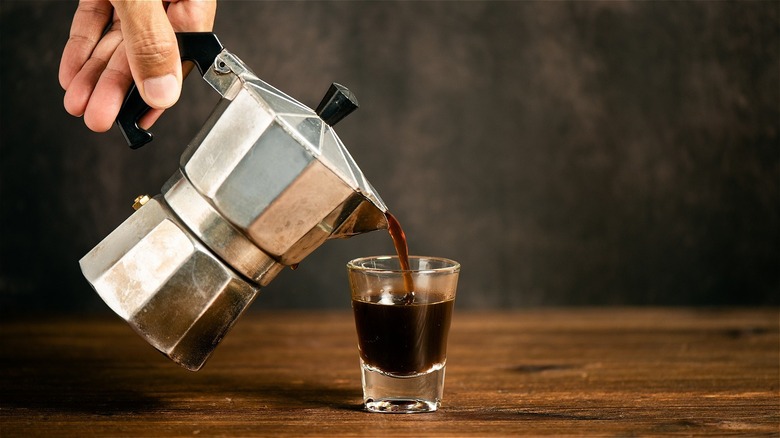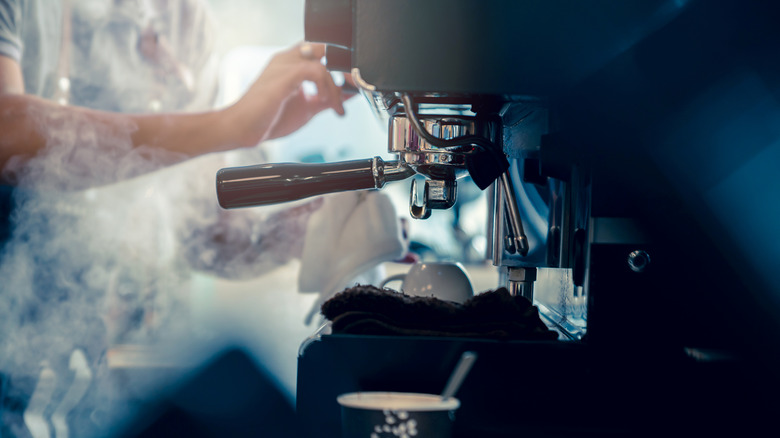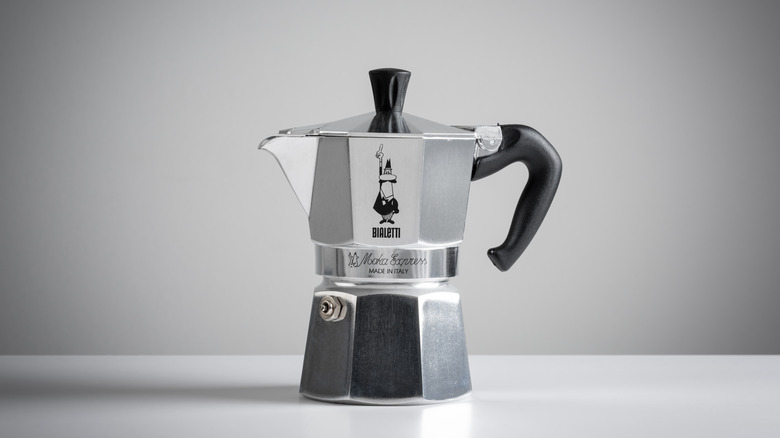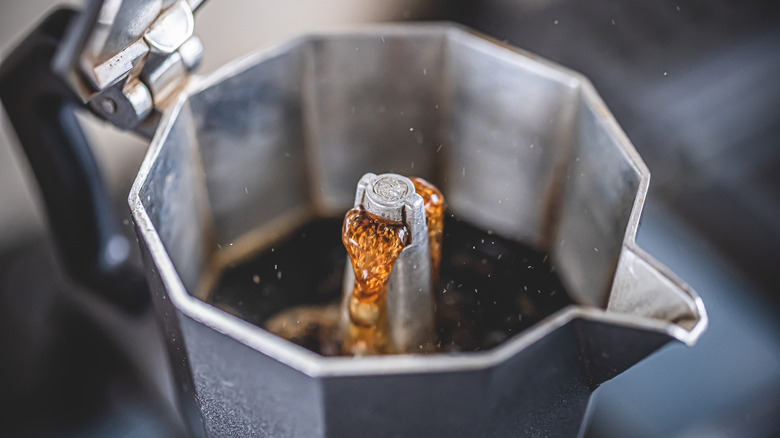The Long History Of Instagram's Famous Moka Pot
The shiny, silvery instruments of the coffee-making world can be intimidating to the uninitiated. Add to that the scalding hot water involved in brewing, the leering hiss of a behemoth espresso machine — with its sporadic spurts of steam popping forth like volcanic activity — and you could be forgiven for being downright fearful of the entire process. Coffee aficionados don't tend to put anyone at ease either, throwing around terms like "third wave," "chemex," and "percolate." And if you want to avoid the coffee snobs and save yourself a few bucks by brewing your own coffee at home, you have a whole new problem on your hands: Do you go French press? Pricey home brewer? Coffee pods?
One way to simplify your coffee life is with a single, inexpensive, Italian invention called the moka pot. Born of a growing coffee trend in post-war Italy (via Atlas Obscura), and made famous by the Bialetti — whose prism-y, cylindrical creation is perhaps the most iconic — the moka pot is one-stop shopping for anyone interested in a strong cup of coffee at home, without the hassle, expense, and negative environmental impact of other methods like the Keurig (per The New York Times). Plus -– and this is important –- the moka pot will be great for your Instagram feed. How did a stovetop coffee maker, no bigger than a pint glass and allegedly inspired by a laundry boiler, become an Instagram influencer? Let's get into it.
Steam work makes the dream work
In the 19th century, the hottest technology around was as hot as any hot new tech can be ... because it was steam. As Encyclopedia Britannica explains, when the power of steam was unleashed, there was no limit to its applications. Steamboats! Steam locomotives! Let's turn this sailing ship into a steamship and see how far we can get! And when you've got a hammer, everything starts to look like a nail. It wasn't long before people were looking at their sad little coffees, made by mixing grounds and hot water and allowing the residual silt to settle on the bottoms of their cups, and wondering — can steam make this better?
Yes, sad little coffee-drinkers, steam can make it better. Because with steam comes a bit of pressure, which means faster, stronger, dare we say better coffee. The first steam-powered espresso machine was patented in 1884, according to Atlas Obscura, and served as the blueprint for the world's first moka pot, which would make an appearance almost exactly 50 years later. A three-chambered pot (not chamber-pot) that uses steam to push hot water through your coffee, the moka pot wouldn't be here today if it weren't for steam. And does it ever call? Ever write? Ever once say thank you? Not on your life, buster. But that's coffee for you.
Italian design meets falling aluminum prices: A love story
As the saying goes: when there's blood on the street, buy aluminum ... or, er, something like that. All that moka pot founding father Alfonso Bialetti knew in 1918 was that he was a metalworker in Piedmont, aluminum was cheap, and that there had to be more than this provincial life (via Atlas Obscura). He began to make pots and pans, previously cast in iron, out of the more lightweight aluminum that he had seen during his years working abroad. Then, he set his sights on coffee.
Legend has it (according to the Independent), that Bialetti drew inspiration from some neighboring washerwomen. As he watched their sealed-boiler spray soapy water over soiled clothes, via a central pipe that would pull water from the bottom of the boiler, he realized that the same science might just translate nicely to a good cup of joe. Stainless steel was at a premium for political reasons, so Bialetti got out his trusty aluminum and some espresso- (and washing-) machine schematics, and he got to work miniaturizing the process. When his son commissioned a cartoon of a mustachioed man to adorn the tiny espresso maker, presto! An iconic moka pot was born. Today there are many types of moka pot on the market, but the famous Bialetti is still the aluminum-gold standard.
A 19th century coffee pot parachutes into 21st century social media
As a writer for The Strategist explains, the "Bialetti Moka Express Stovetop Espresso Maker," the official moniker for Alfonso's creation, is "the granddaddy of all moka pots." Priced around the $20 mark, it's also an inexpensive way to make a strong cup of coffee that tastes as good as the stuff you'd get at Starbucks. But the Bialetti's appeal isn't only in the price tag. Its iconic lewk is tailormade for social media, and the process by which it steam-brews a basket of beans is worthy of an Instagram reel -– which is the highest compliment you can pay a coffee pot, really. And the other moka pots on the market are every bit as aesthetically pleasing as their predecessor, with beautiful coffee choreography to boot.
As described by writer Alex Tewfik in an article for Philadelphia Magazine, a morning moka pot routine is practically a mindfulness ritual: filling the water chamber, adding the coffee, and waiting for the pot to work its magic as it heats. Watching the crema — a frothy, brown foam that signals your espresso is on its way — slowly bubble out of the moka pot's central pipe is mesmerizing, so it's no surprise that Instagram users have seen an opportunity to hit record, set to music, and create a trend. To date, the hashtag #mokapot has an engagement of nearly 200k, where the machine is exalted through photos, watercolors, and moka pot therapy. For a little coffee-maker-that-could, with such a storied past behind it, we see a strong, shiny future ahead.



